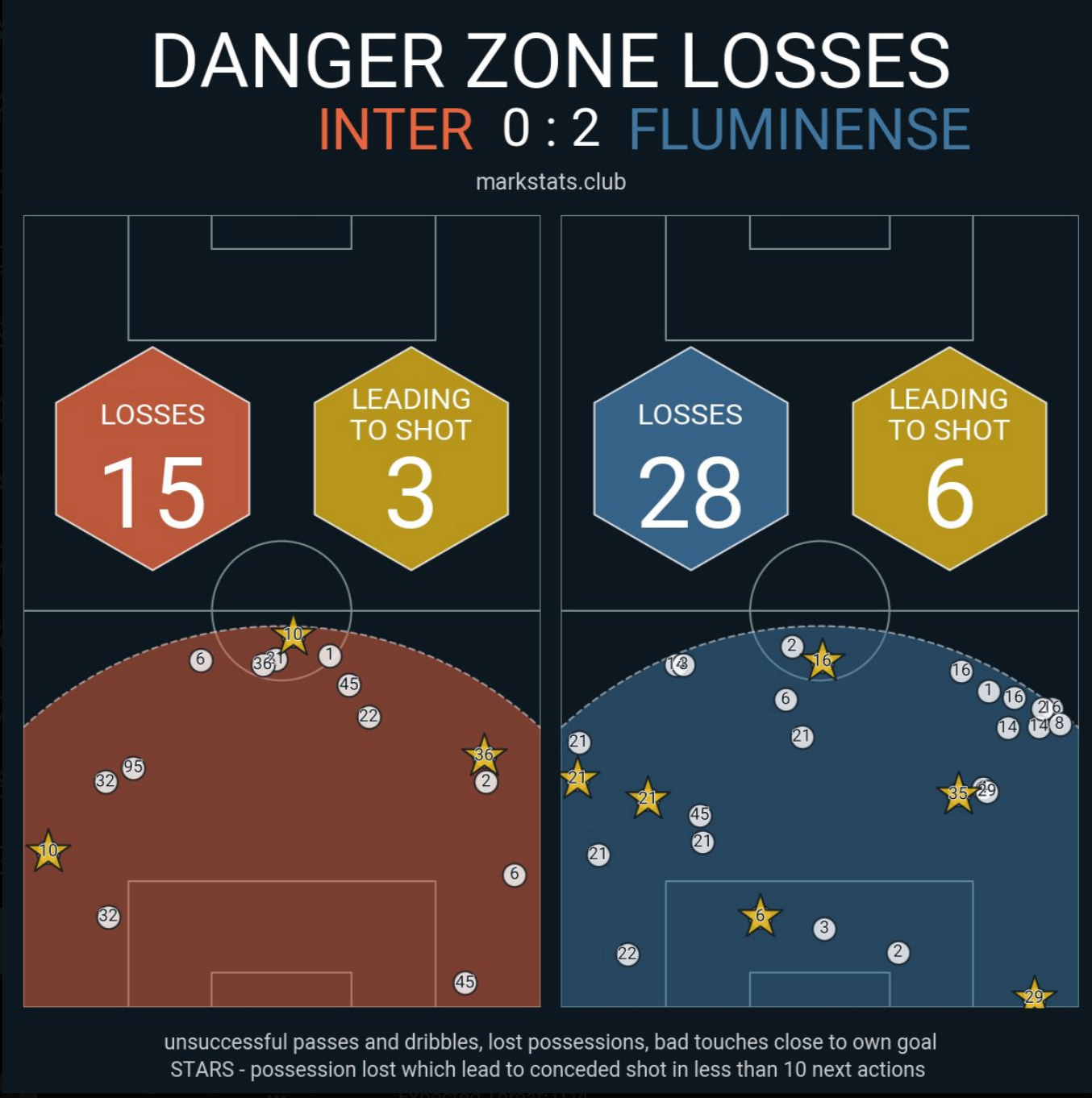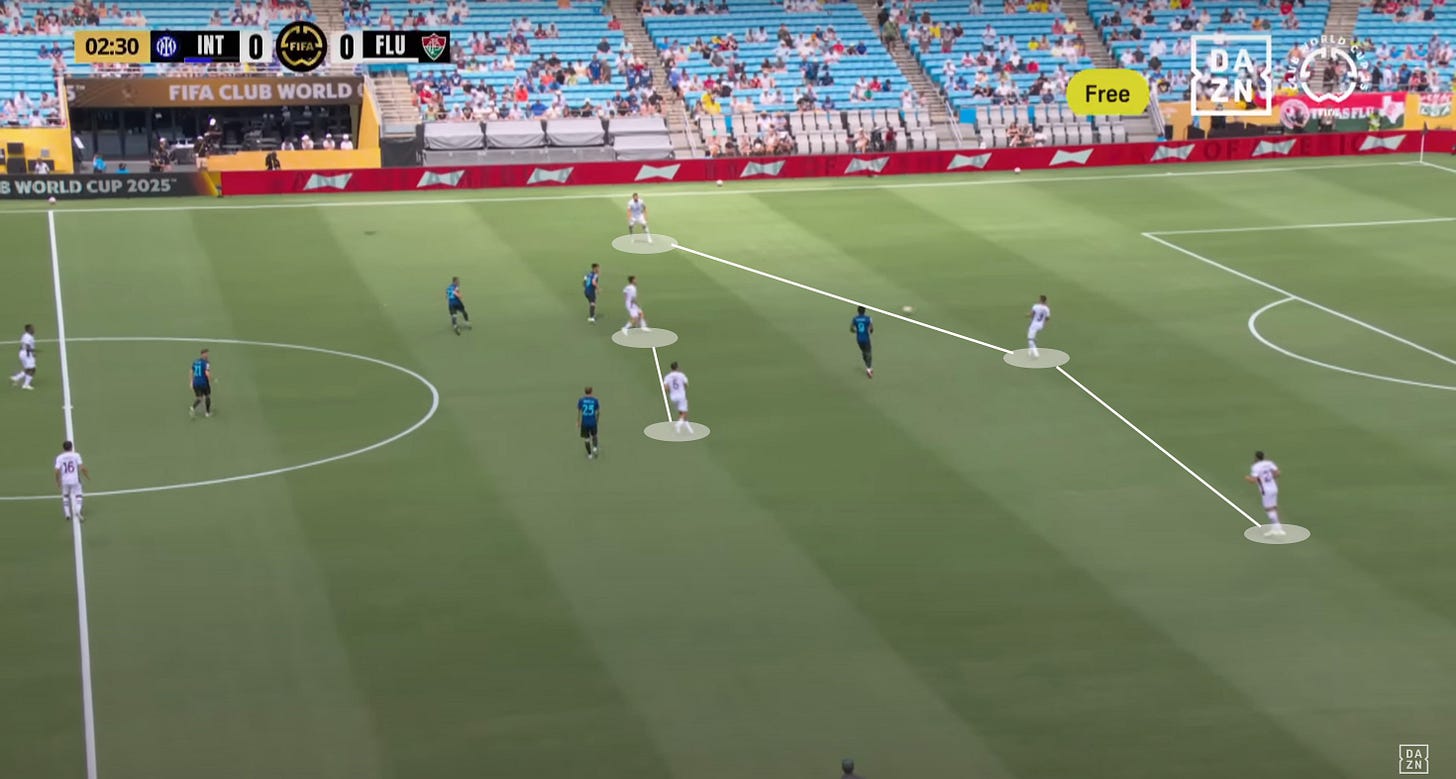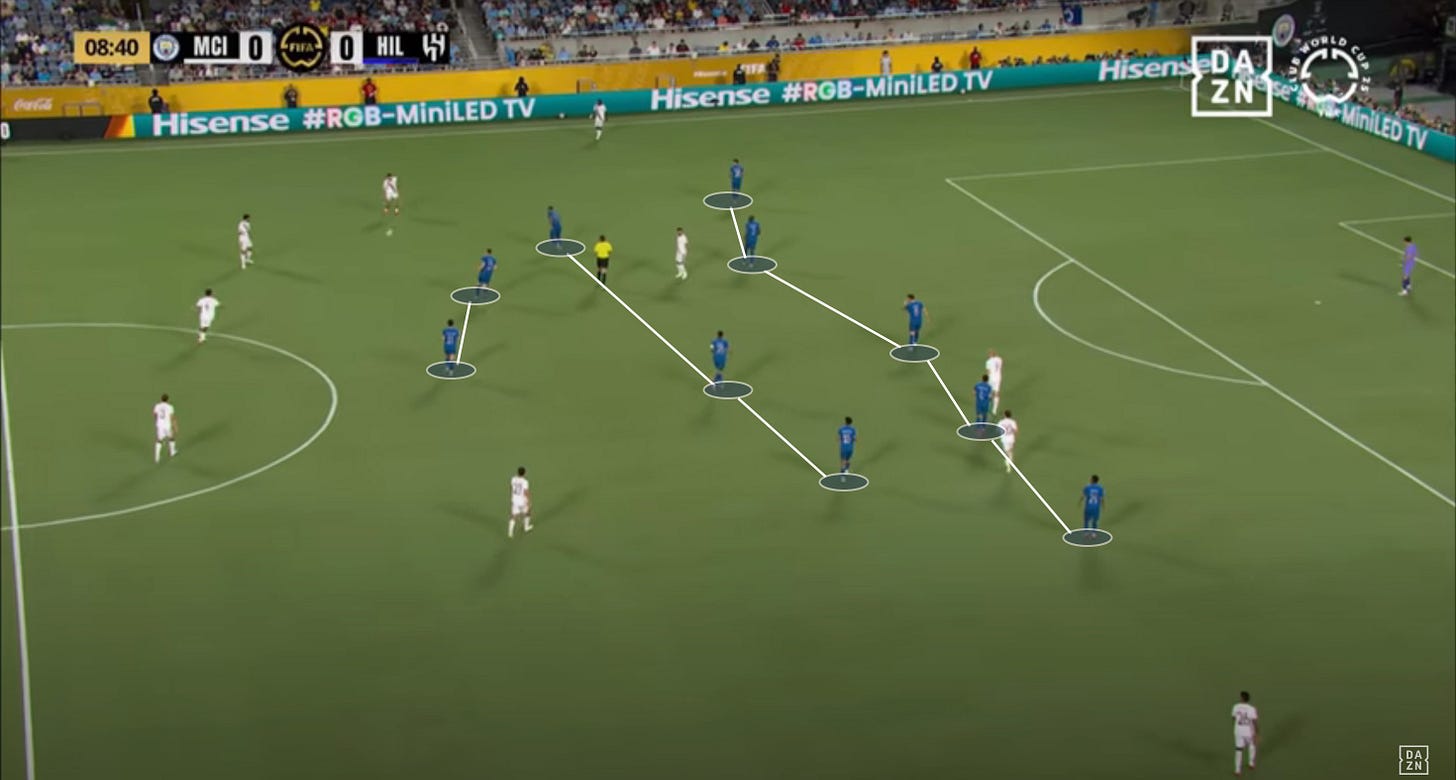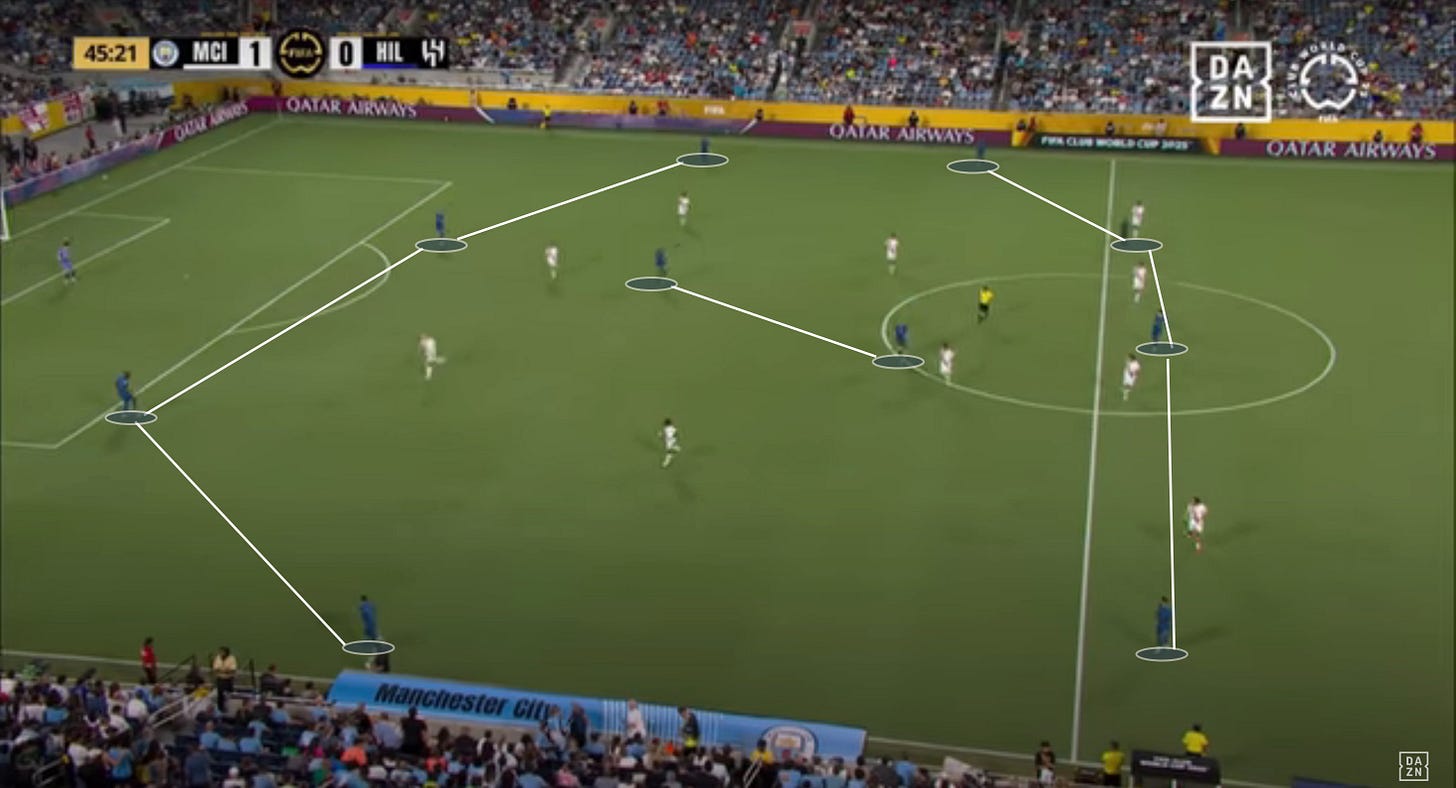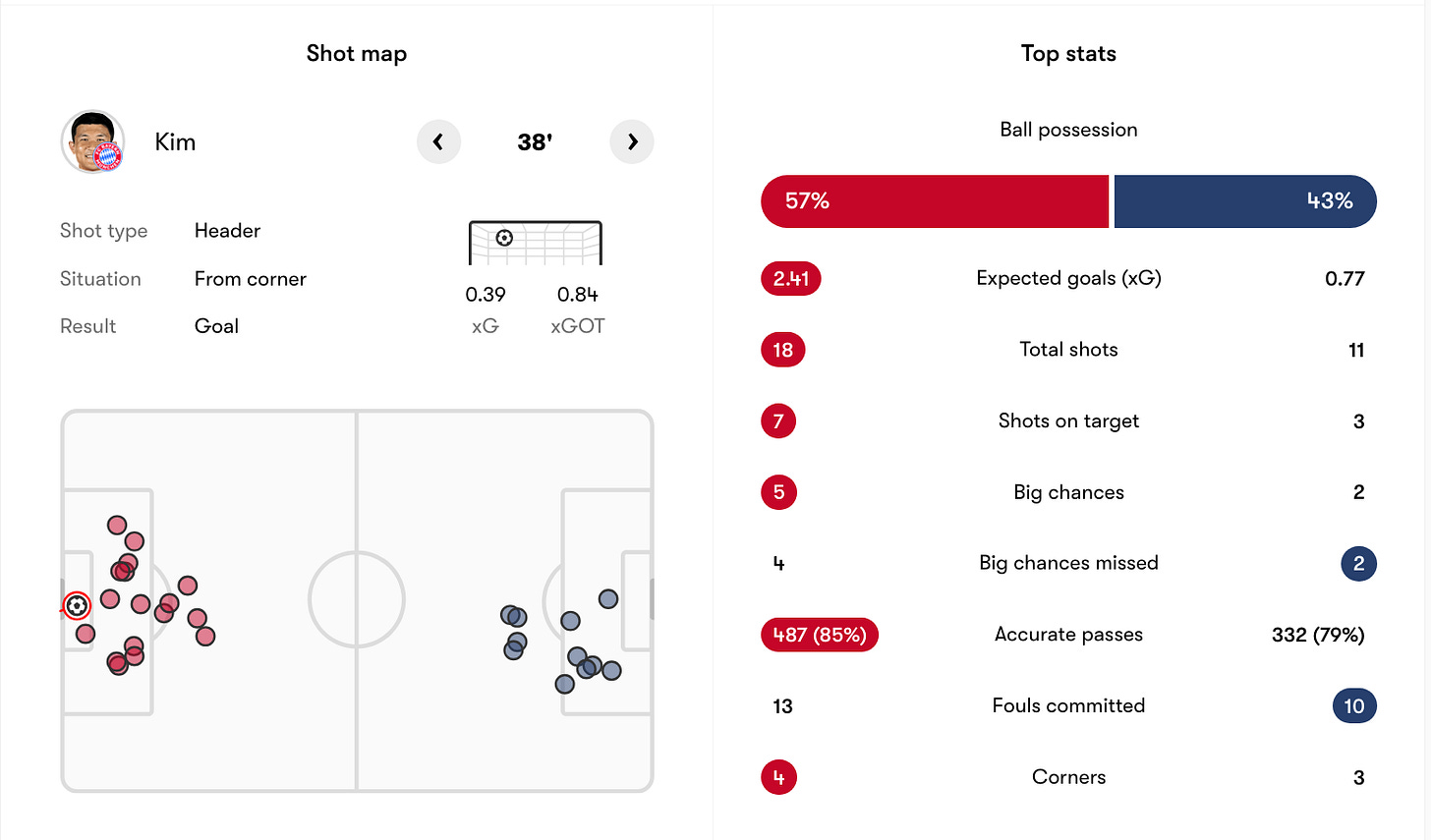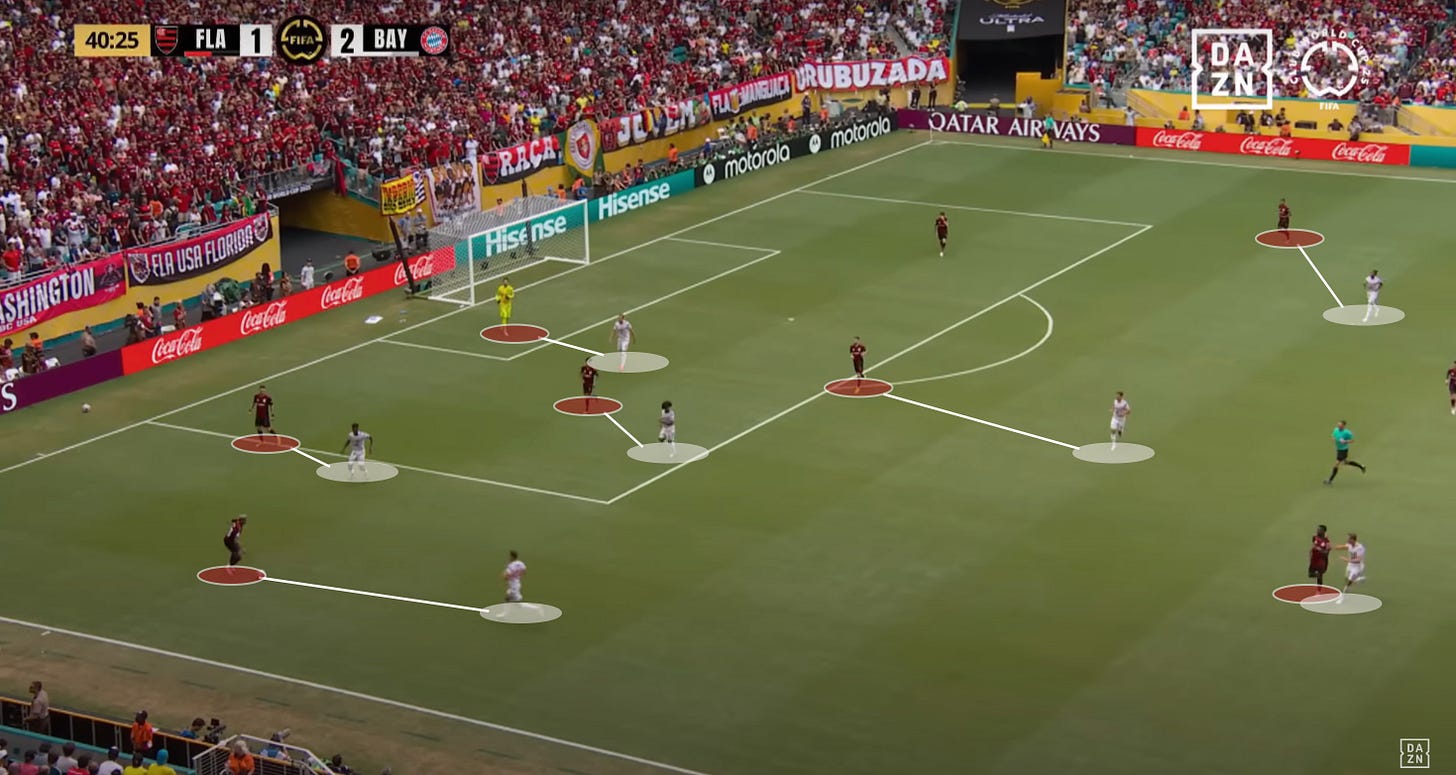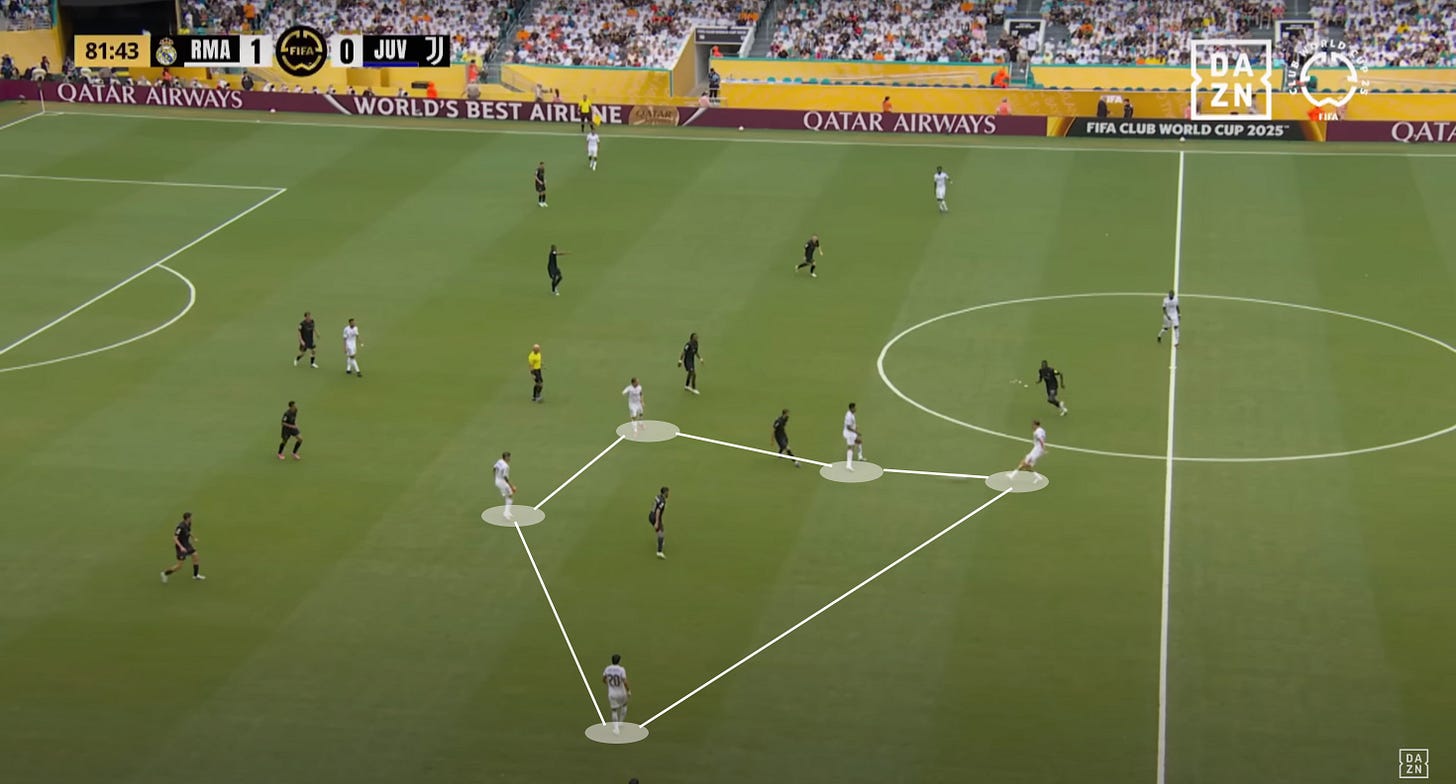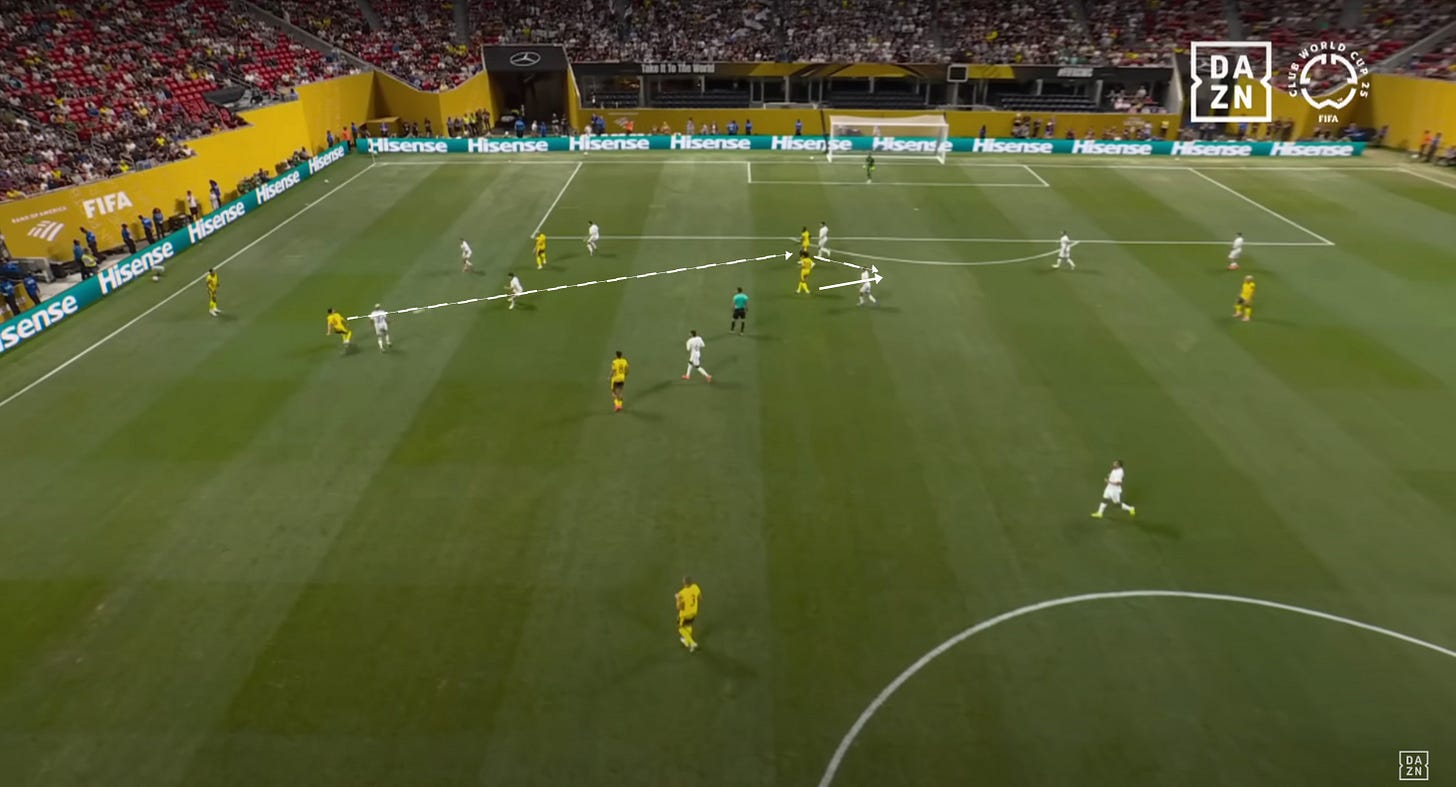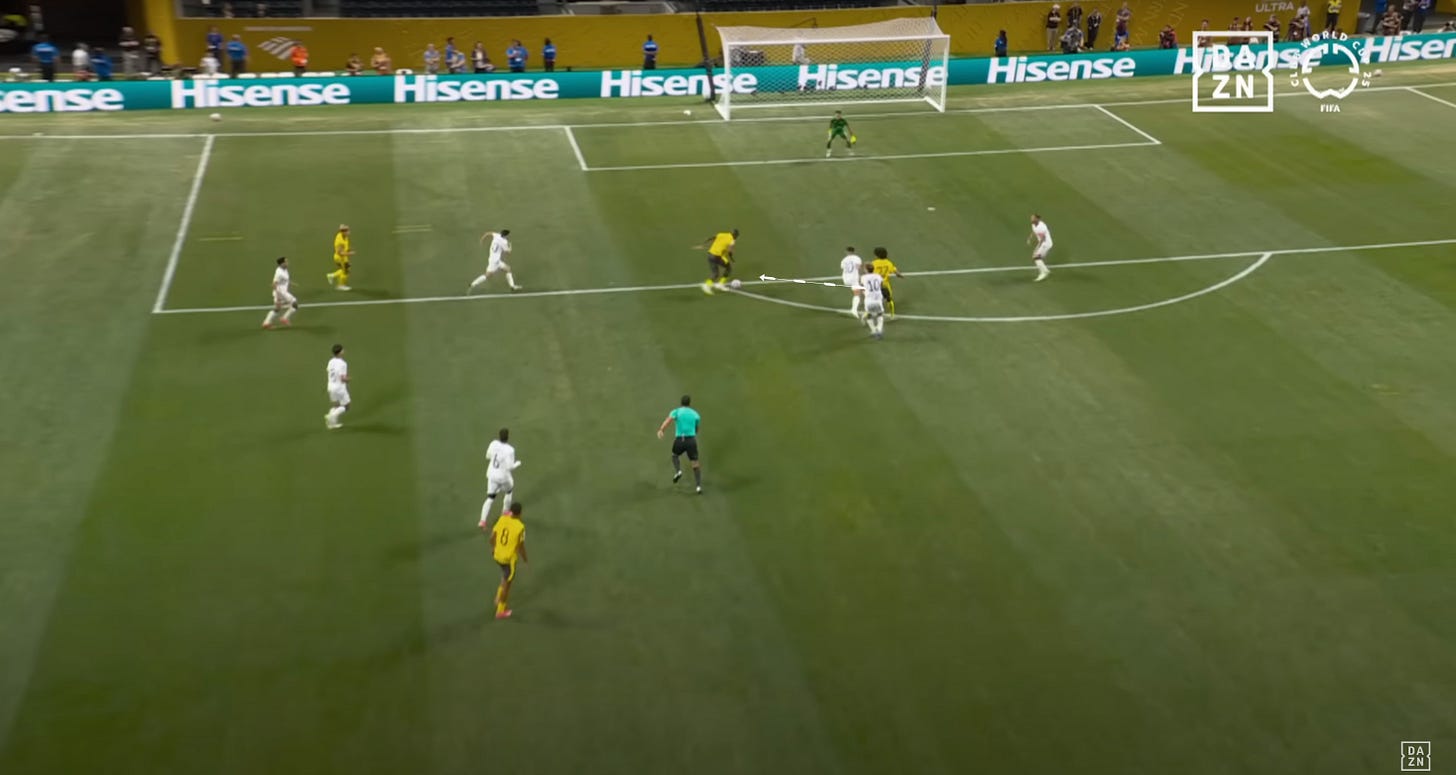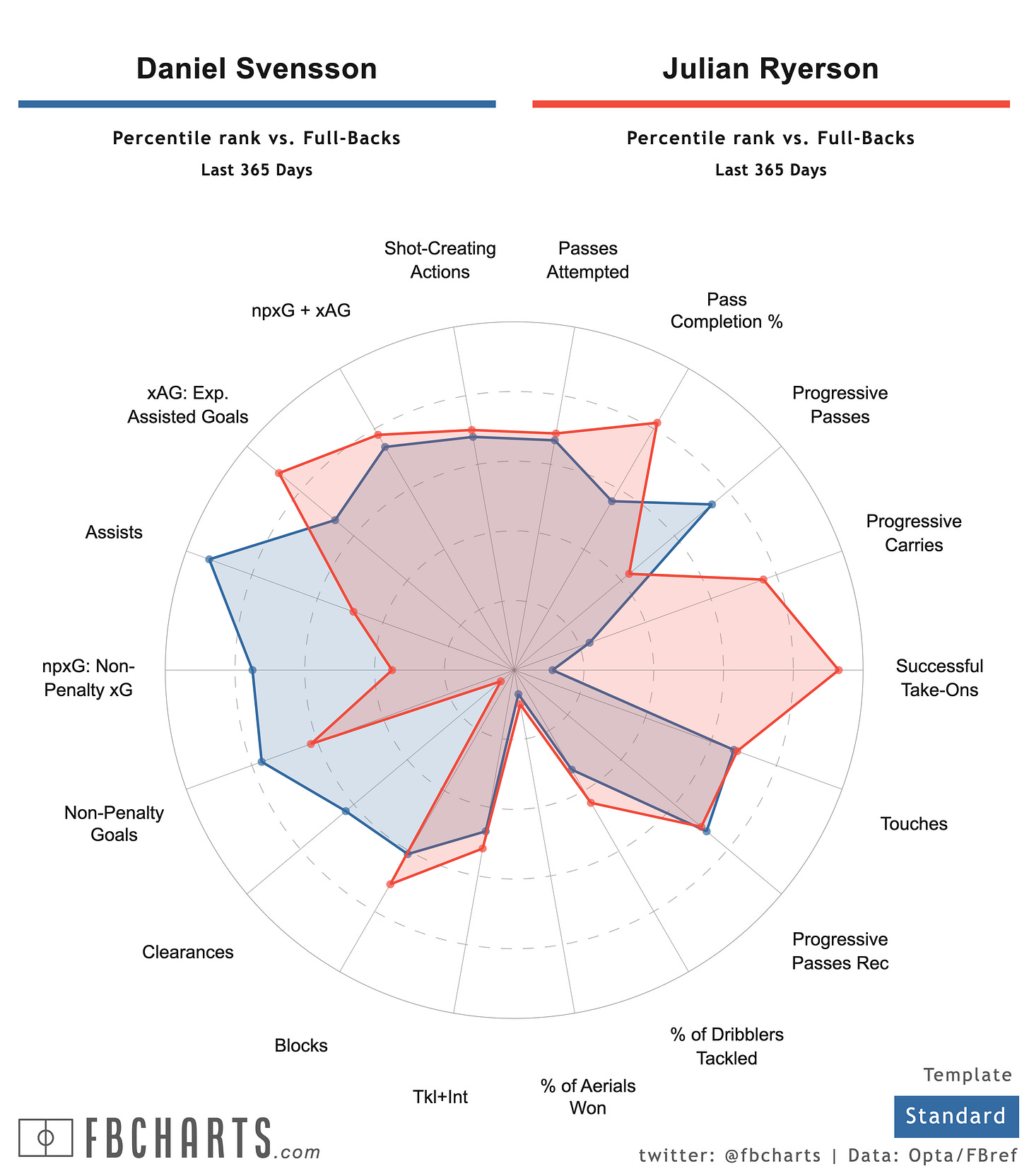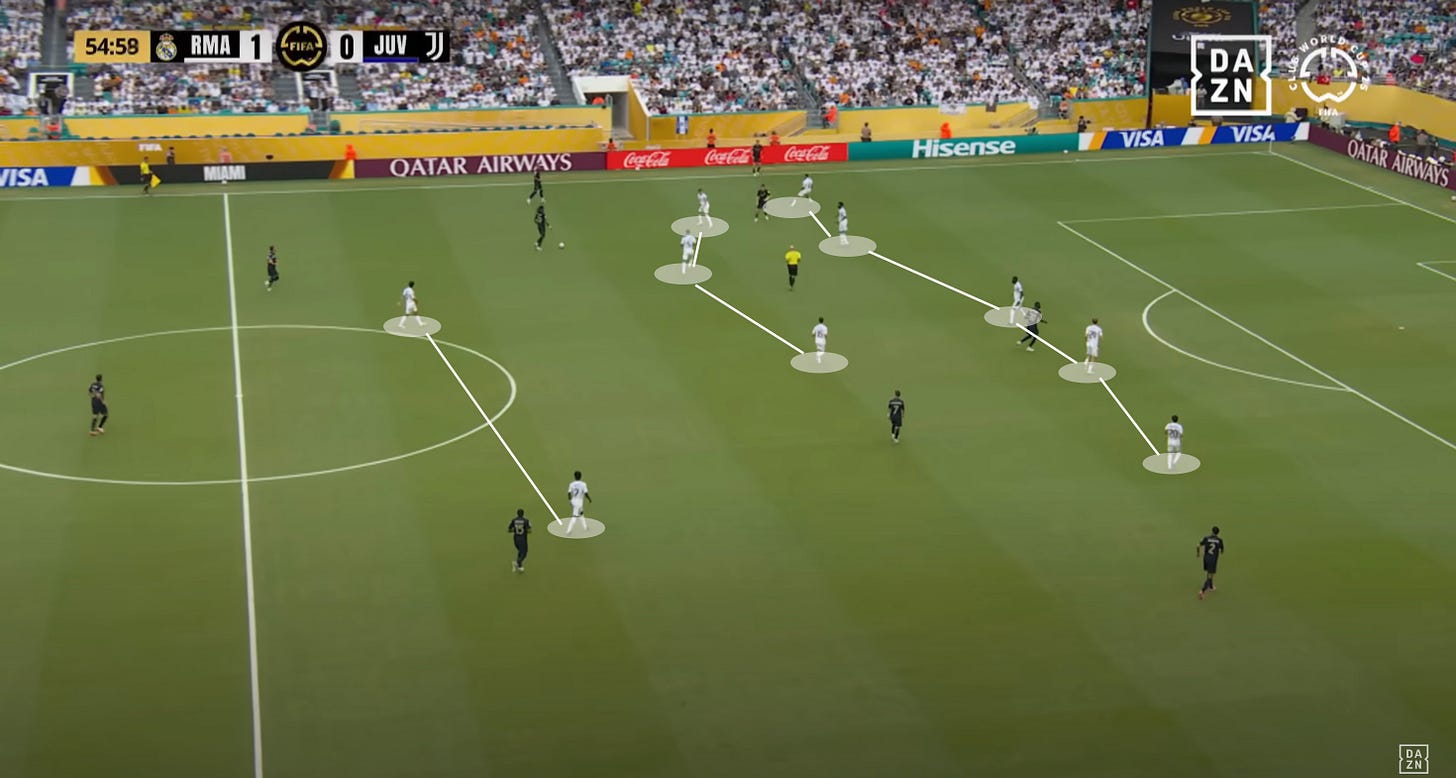Things did not entirely go according to plan in the Round of 16. Fluminense and Al Hilal pulled off massive upsets over Inter and Manchester City, while Chelsea needed extra time to beat Benfica.
There is a couple massive matches for the quarterfinals though in the bottom of the bracket with PSG taking on Bayern Munich and a Champions League final rematch between Real Madrid and Dortmund.
This will not be as detailed as my Premier League ones because it’s the summer and I don’t have the usual amount of data or catalogue of matches on every team. FotMob is about the only site that has aggregated data from the tournament, so that is mainly what I am going to use.
Let’s dive into the quarterfinals.
Fluminense vs. Al Hilal
Fluminense in Possession vs. Al Hilal out of Possession
Well, this is not the matchup we all expected.
Fluminense scored early against Inter so naturally they conceded most of the possession for the match. They are a team that wants to have the ball and play short passes through their opponent.
It can get them into trouble sometimes because their hesitation to play direct. Against Inter they committed 28 danger zone losses, which is a lot considering they only had 32% of the ball.
image via markstatsbot on X
They build up in a pretty standard 3-2 base, with the five guys in the last line of defense all dropping deep to try and create close passing networks to quickly play through the opponent.
Simon Inzaghi’s side will press high, but most of the match against Manchester City and throughout this tournament, they’ve sat in a 5-3-2 low block.
Against Pachuca and Salzburg, Al Hilal kept two clean sheets and only conceded 1.7 expected goals.
Fluminense has only created 3.8 expected goals in their four matches in this tournament, so it’s likely going to be a struggle against Inzaghi’s low block.
Al Hilal in Possession vs. Fluminense out of Possession
Al Hilal tried at times to build up through Manchester City’s pressure and actually did a pretty decent job.
Their best moments came in transition, but in this match they are likely going to be the ones holding a majority of the possession.
The base of Simon Inzaghi’s build up is a 4-2-4 with the midfielders positioning staggered.
The reason for the staggered positioning is because when the ball goes wide to the fullback, the more advanced midfielder can be on the same level as the fullback to make the pass easier.
What Inzaghi tries to do with this build up is create a diamond or even a five man combination out wide to try and overload the opposition.
Fluminense did press Inter’s build up early on and for the match actually ended up with a pretty respectable 8.8 PPDA. However, for a majority of the match they sat in a 5-2-3 mid to low block like the one below.
There are two problems with this type of structure against Al Hilal. First, because Al Hilal build up in a 4-2 base or even sometimes use Bono as a +1, they will always have a numerical advantage through the first phase. When you sit in a 5-2-3 you are giving up space in the wide areas, which will allow Al Hilal to create these types of wide overloads to play through Fluminense.
Fluminense though has been a very solid defensive team throughout this entire tournament. They held Inter to only 1.29 expected goals and have allowed the second fewest percentage of shots from inside their own penalty area. That is why they are only allowing an xG per shot of 0.07, which is the best mark in the tournament.
Palmeiras vs. Chelsea
Palmeiras in Possession vs. Chelsea out of Possession
I have a really hard time seeing how Palmeiras is going to threaten Chelsea.
Take a look at their shot map from their previous match against Botafogo. Of course there are a cluster of shots right around the six yard box. But, only one of those shots came from open play. The rest were off of corners.
image via FotMob
As you can see basically the only chances the Palmeiras had from open play were shots that came from outside the box. Ending with 1.29 expected goals off of 19 shots is incredibly inefficient.
The good news for Palmeiras is unlike the other Brazilian teams they haven’t been solely reliant on relationsim and short passing throughout this tournament. Per Opta the Analyst, Palmeiras have the second most direct attacks with nine, compared to just three build up attacks. Of the teams that are still remaining in the tournament only Fluminense has fewer 10+ pass sequences.
Chelsea’s press had some issues on the left side with Marc Cucurella not backing up the press and forcing Cole Palmer to cover two players. This made it pretty easy for Benfica to get through the first phase.
However, when they sat back in more of a midbock they really started to get more and more effective turning Benfica over. They forced 11 high turnovers in the match and as you can see from the location, most of them were right in the center of the pitch as Benfica was entering the second phase of build up.
image via markstatsbot on X
Chelsea have maintained an effective high line in this tournament because they have drawn the most offsides (16) and they are averaging almost 10 high turnovers per match.
I guess the real question is can they keep their new signing Estêvão in check? He only had one successful dribble out of five against Botafogo and Cucurella is a really good defender if he’s lining up at his usual right wing position.
Chelsea in Possession vs. Palmeiras out of Possession
Chelsea struggled to break down Benfica for a majority of the match and this is the reason why.
The book is out on Maresca because he has Chelsea set up to do the same thing over and over again when they are trying to break down low blocks.
In a sense he doesn’t care because it allows Chelsea to maintain control of the match, tilt the field on their opponent, and also allows them to easily counterpress.
However, it’s counter intuitive because they cannot ever break through the middle in situations like this:
As you can see Benfica have them outnumbered 6 v 5 through the middle.
In the end you’ll see the final score of 4-1 and Chelsea creating 2.7 expected goals. However, before the Benfica red card, the Blues had only managed to create 0.87 expected goals with their lone goal in regular time coming for a Reece James freekick.
What they can do in this match though is try to utilize Palmer and Fernandez to pull Palmeiras’ players out of position.
Palmeiras will sit in a low block, but it’s mainly a man marking system, so when players drop in, defenders will often follow them. That can be effective for Delap to make runs into the space created by Fernandez or Palmer. Chelsea will just have to be aggressive because the gaps where there at times against Benfica, but they were too hesitant to make the risky pass.
Bayern Munich vs. PSG
Bayern Munich in Possession vs. PSG out of Possession
These two met very early on in the Champions League in Munich and Bayern was very dominant.
The match ended 1-0, but the German champions dominated the match from start to finish.
image via FotMob
Now, it’s been a long time since that match and PSG has certainly improved, but I really question how they are going to effectively press Bayern Munich. Last season, the only team to effectively press Bayern and completely nuetralize them was Xabi Alonso’s Leverkusen.
In the second meeting, Bayern was held to 0.07 expected goals because Leverkusen went full man to man and forced Vincent Kompany’s side to play very direct.
image via @LamdarhriAchraf on X
In that previous meeting, PSG forced four high turnovers and had a PPDA of 11, which far from elite. Bayern Munich was able to maintain a 65% field tilt on them and completely control the match from start to finish.
If PSG is not able to effectively and aggressively press Bayern’s build up then they are going to be in some trouble.
The one time they’ve been forced into defending in a low block this season was both legs against Arsenal in the Champions League semifinal. The Gunners are a team that really struggles breaking down low blocks and even they were able to create almost six expected goals over the two legs. Imagine what Bayern can do to them in Vincent Kompany’s 2-4-4 build up.
PSG in Possession vs. Bayern Munich out of Possession
There was a very real thing that happened to PSG for a very long time. Whenever they faced elite pressing teams they had no way of playing out of the back.
That has changed this year because of the ability of their positional rotations, but mainly the ability of Ousmane Dembélé to drop deep to create an overload. He did it against Arsenal and Liverpool for a couple of goals because the centerbacks wouldn’t follow him into a precarious position not wanting to leave space inbehind for PSG wingers to run into.
As you can see Arsenal have gone man to man and have every passing option covered, so Dembele is giving them an option to play to.
That is something to watch for in this match because Bayern Munich is as aggressive as it comes when it comes to pressing.
Take a look at this example against Flamengo. It’s full man to man everywhere and the only real option is switch the play to the other side of the pitch or play a direct ball up to the forward.
Arsenal is the closest thing that PSG has seen recently to the type of pressure Bayern Munich can provide. Over the two legs of the Champions League semifinal, Arsenal forced 60 danger zone losses and 15 high turnovers.
PSG will use Vitinha and Neves dropping into the last line of defense to help them gain a numerical advantage, but Arsenal in large part took those types of easy passes away.
That meant Dembélé and the other forwards dropping in was crucial for PSG to actually build up successfully.
Of course they always have the option to play direct balls to their wingers and let them do damage 1 v 1, but I know Luis Enrique will want to find solutions to build out of the back so PSG can have more control than they did the last time they played Bayern Munich.
Watch for Upamecano tracking Dembélé wherever he goes. He consistently will step up in both high press and counterpressing situations. His aggressiveness won possession and allowed Harry Kane to score the second goal against Flamengo.
Real Madrid vs. Dortmund
Real Madrid in Possession vs. Dortmund out of Possession
Real Madrid still have a long way to go to truly reaching the peak of Xabi Alonso’s system, but they are getting there.
They are starting to find ways of playing through their opponents by utilizing overloads and quick passes, just like Leverkusen did.
These types of short passing distances make it very easy for them to play through a low defensive block like the one they faced against Juventus. Because in this scenario they have a 5 v 3 it opens up a passing lane for Huijsen to find Valverde inbetween the lines.
The problem though is Real Madrid didn’t really find a way through for a majority of the match because they are often funneling the ball out wide and trying to allow Vinicius Jr. to create most of their chances.
When a team like Juventus just sits back and doesn’t step up to allow space in behind, you can get pass maps that look like this:
image via markstatsbot on X
They are going to face another 5-3-2 low block on Saturday because that is what Dortmund played against Monterrey. They also conceded a lot of possession and didn’t really press the Mexican side effectively.
The switch to playing a back five has really helped Dortmund out a lot defensively. Kovac made the switch after their 2-0 defeat to RB Leipzig in March. The numbers haven’t been much different between defending in a back five or four, but adding a third centerback has allowed them to not get overloaded on the last line by elite teams.
They haven’t played anybody near the level of Real Madrid in this tournament so far. So, if we go back towards the end of the season, they did concede 2.2 expected goals to Xabi Alonso’s Leverkusen despite winning that match 4-2.
Dortmund in Possession vs. Real Madrid out of Possession
I mentioned this in my last preview, but Dortmund love to play 1-2s with Guirassy and the forwards.
The change to a 3-4-2-1 type formation has allowed Karim Adeyemi to play a more inverted role in possession, which helped Dortmund score their first goal against Monterrey.
Adeyemi is also really dangerous in transition moments, which will be key in this match. He will drift out wide so the fullbacks when the ball is won can play him space to utilize his pace.
The other added benefit of switching to a 3-4-2-1 shape is the fullbacks Svensson and Ryerson can pay a more advanced role in possession. Dortmund will often build up in a 3-2-5 shape with both of their fullbacks pushing high and hugging the touchline to provide width.
Both of them have been providing a lot to the attack throughout this tournament and Svensson actually leads the Club World Cup in expected assists, along with creating seven chances.
Real Madrid only forced one high turnover against Juventus in large part because they were holding a majority of the possession and most of Juventus’ attacks came in transition.
One thing that you are likely going to see Alonso do out of possession is have Real Madrid defend in a 5-3-2 as opposed to the 4-4-2 they used under Ancelotti.
The benefit of this Aurélien Tchouaméni can drop into the right centerback position to cover for Trent Alexander-Arnold, similar to how Konate covered for him at Liverpool.
The 5-3-2 in this specific makes sure that Dortmund isn’t able to overload the last line of defense and that they have central cover for Guirassy to make sure he isn’t easily able to receive the ball.
Kovac’s Dortmund scored four goals against Xabi Alonso’s Leverkusen in the second to last match of the Bundesliga season, but they only created 1.2 expected goals on nine shots and Leverkusen controlled a majority of the possession.
The same will be true here against Real Madrid, Dortmund will have to capitalize on the few chances they get to make it to the semifinals.





